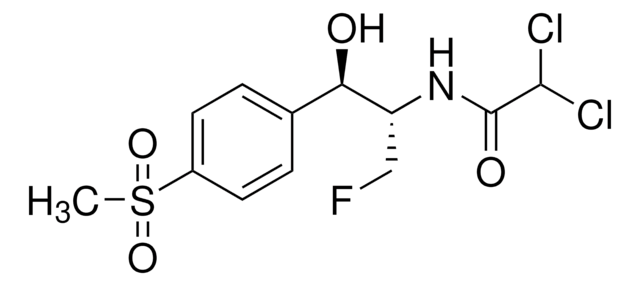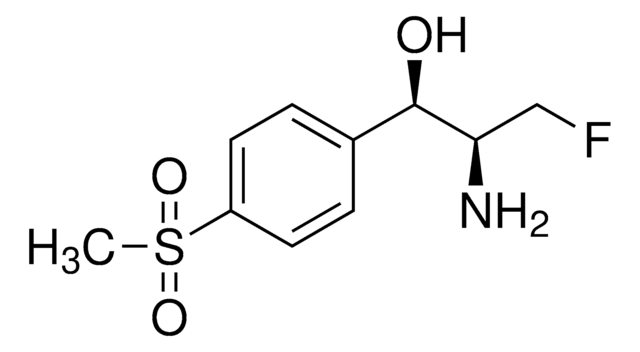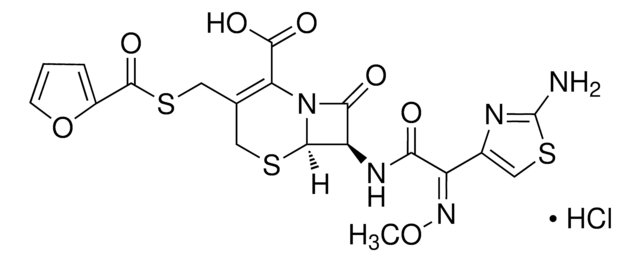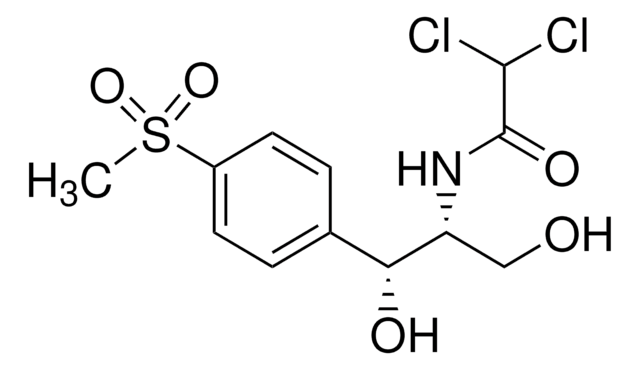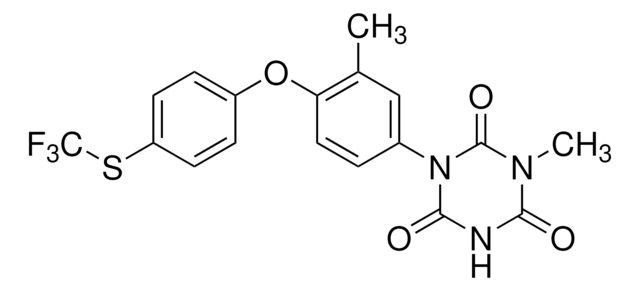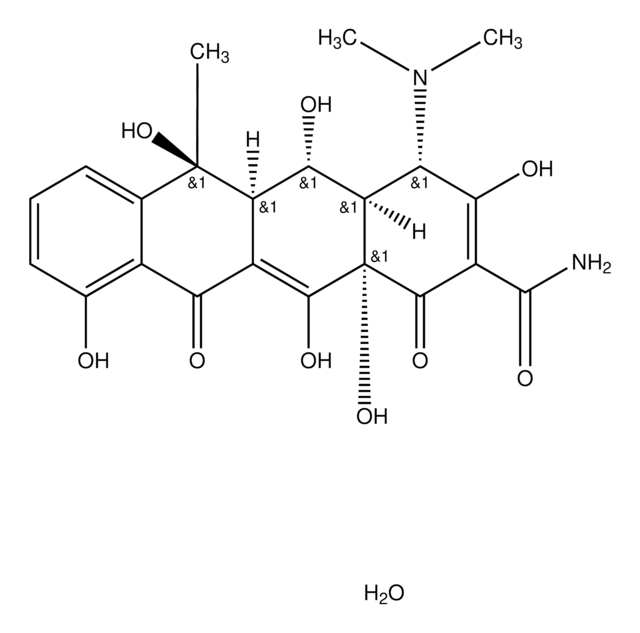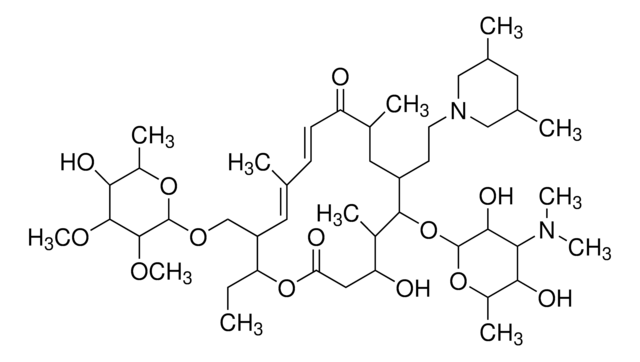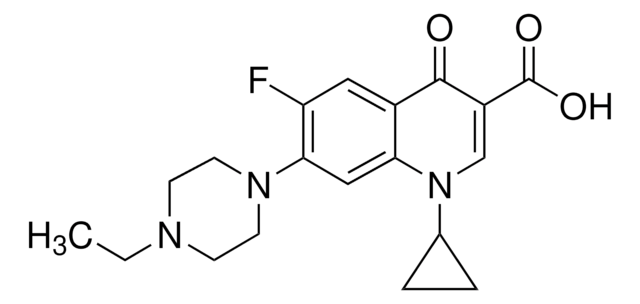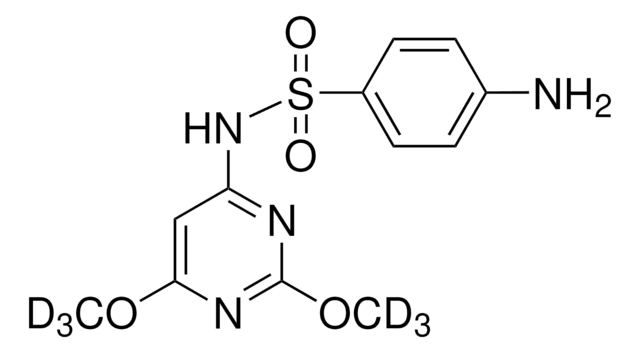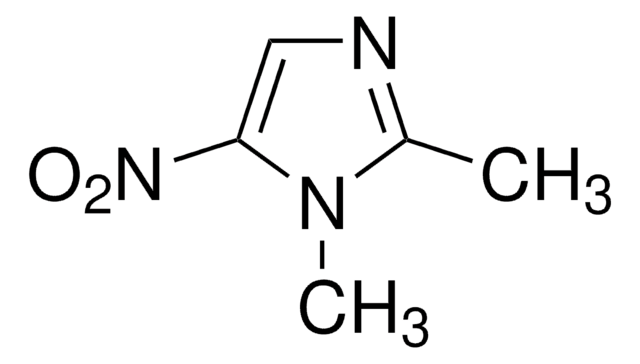推荐产品
等級
analytical standard, for drug analysis
品質等級
形狀
solid
技術
HPLC: suitable
gas chromatography (GC): suitable
應用
forensics and toxicology
pharmaceutical (small molecule)
veterinary
形式
neat
SMILES 字串
CS(=O)(=O)c1ccc(cc1)[C@@H](O)[C@@H](CF)NC(=O)C(Cl)Cl
InChI
1S/C12H14Cl2FNO4S/c1-21(19,20)8-4-2-7(3-5-8)10(17)9(6-15)16-12(18)11(13)14/h2-5,9-11,17H,6H2,1H3,(H,16,18)/t9-,10-/m1/s1
InChI 密鑰
AYIRNRDRBQJXIF-NXEZZACHSA-N
正在寻找类似产品? 访问 产品对比指南
一般說明
Florfenicol is a broad-spectrum amphenicol antibiotic used against diseases affecting domestic and wild animals.
應用
The analytical standard can be used as follows:
- To measure florfenicol and its main metabolite florfenicol amine in tilapia meat by solid phase extraction (SPE) and ultra high-performance liquid chromatography-tandem mass spectrometry (UHPLC-MS/MS)
- Multi-residue analysis of three amfenicols in animal feed samples by HPLC-MS/MS method, following European Commission Decision 2002/657/EC(2)Determination of florfenicol in different animal feedstuff samples by thin layer chromatography (TLC) coupled with HPLC-UV detection
- Residue analysis of florfenicol in broiler meat and liver samples by a reversed phase-HPLC method in combination with UV detection at 223 nm
- Competitive indirect-chemiluminescent enzyme-linked immunosorbent assay (CL-ELISA) based quantitative analysis of florfenicol and its major metabolite florfenicol amine in chicken muscle samples, validated as per Commission Decision 2002/657/EC
其他說明
Refer to the product′s Certificate of Analysis for more information on a suitable instrument technique. Contact Technical Service for further support.
訊號詞
Danger
危險聲明
危險分類
Aquatic Acute 1 - Aquatic Chronic 1 - Repr. 2 - STOT RE 1
標靶器官
Liver,Brain,Testes,Spinal cord,Blood,gallbladder
儲存類別代碼
6.1C - Combustible acute toxic Cat.3 / toxic compounds or compounds which causing chronic effects
水污染物質分類(WGK)
WGK 3
閃點(°F)
Not applicable
閃點(°C)
Not applicable
個人防護裝備
Eyeshields, Gloves, type N95 (US)
其他客户在看
Ye Duan et al.
Applied biochemistry and biotechnology, 180(8), 1644-1656 (2016-09-11)
Chloramphenicol (CAP) has been widely used to treat bacterial infections in livestock and aquatic animals. To reduce the risk of CAP residues, an efficient technology to rapidly detect CAP residues in animal-sourced food is expressly needed. In this study, magnetic
Chun-Liu Dong et al.
Frontiers in pharmacology, 8, 553-553 (2017-09-07)
Invasive infections due to
J R Craig et al.
Journal of animal science, 95(11), 4904-4916 (2018-01-03)
Gilt progeny (GP) are born and weaned lighter than sow progeny (SP) and have higher rates of mortality. This study aimed to quantify the performance and survival differences between GP and SP throughout the entire production cycle from birth to
Jacob M Swift et al.
Foodborne pathogens and disease, 14(3), 160-166 (2017-01-12)
Small ruminants have been implicated in outbreaks of Escherichia coli O157:H7 at livestock exhibitions throughout the United States. Additionally, goat meat or milk may serve as a reservoir for foodborne transmission of the organism. These associations highlight the public health
Joren De Smet et al.
Frontiers in pharmacology, 9, 1265-1265 (2018-11-22)
Florfenicol, which is licensed for veterinary use only, proves to be a potent antimicrobial for treatment of respiratory disease. However, the subsequent exposure of the gut microbiota to florfenicol is not well described. Hence, the effect of various administration protocols
我们的科学家团队拥有各种研究领域经验,包括生命科学、材料科学、化学合成、色谱、分析及许多其他领域.
联系技术服务部门